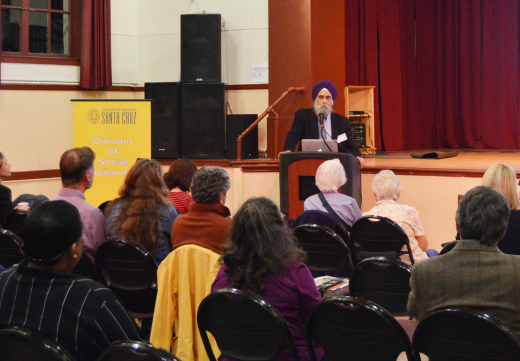How and why politics and policy are failing minority groups was a central theme at the UC Santa Cruz Division of Social Sciences’ fourth annual research event, "Politics of Change?! The Social Sciences Take on 2016."
Campus and community members gathered at the Santa Cruz County Veterans Memorial Building Wednesday (Oct. 19) as the speakers discussed how their research applies to politics and change.
Campus Provost and Executive Vice Chancellor Alison Galloway and Dean of the Social Sciences Division Sheldon Kamieniecki kicked off the evening and Carla Hesse, dean of the College of Letters and Science at UC Berkeley, delivered the keynote, "Is There a Revolution in the Social Sciences?"
"Most of the problems we face exceed the nation-state framework,” said Hesse. Major problems such as climate change, migration, economic security are beyond the reach of government structure and sovereignty. These issues do not have any borders, she added. Similarly, the social sciences are seeing traditional disciplinary borders bleed into other disciplines. As a result, an epistemological shift is happening. Social scientists need new questions and tools to address these new problems, she said.
The 14.8 percent
One of the new challenges social scientists are addressing is rising poverty in America. Heather Bullock, professor of psychology and director of the UC Santa Cruz Blum Center on Poverty, Social Enterprise and Participatory Governance, shared what beliefs about poverty and wealth influence specific political outcomes.According to latest census data, 43.1 million people or 13.5 percent of the U.S. population live in poverty; shared prosperity ended in the 1970s. What do Americans think about the nation’s wealthy and poor, and how do attitudes influence decisions in economic policy?
For example, believing individual characteristics account for a person’s poverty (e.g. seeing the poor as lazy, unmotivated, disinterested in education and unable to spend and save money) will lead to restrictive welfare and housing policies and tax policy that benefit the wealthy, Bullock said.
In contrast, believing that poverty can be attributed to structural issues (e.g. underfunded schools, low-paying jobs, and discrimination against people of color and low-income groups) results in progressive welfare policies, supportive housing policies, and a rejection of tax policies that benefit the wealthy.
Another 1 percent
Then there are Indians in the U.S., who make up 1 percent of the population, and according to new research from Nirvikar Singh, distinguished professor of economics also have some of the highest levels of educational attainment and income of all foreign- and native-born groups in the country.
Highlighting findings from his forthcoming book, The Other One Percent: Indians in America (Oxford University Press, 2016), Singh asked how did a population from a poor developing nation with low human capital achieve this rank in the world’s most advanced nation?
Singh argued that Indian Americans are the outliers, with a distinct immigration status that is employment based rather than family based. For example, Indian Americans maintain a strong and increasing concentration in the technology sector and are entrepreneurial. Recent studies have found that 6-8 percent of high-tech start-ups had Indian-origin founders, he shared.
The 8 percent
Sociologist Veronica Terriquez asked why have young adults become politically disengaged. Her current research explores how grassroots youth organizing efforts in California catalyzed civic and political engagement with young people.
In 2014, only 8 percent of California voters ages 18-24 turned out to vote. For the 65-74 demographic, the number was 57 percent.
“Your grandparent is seven times more likely to vote,” she said. Millennials feel powerless, uniformed, overwhelmed, and frustrated, she said.
But when young people belong to a civic organization they remain politically active into adulthood.
“Young people have to rely on each other to get out and vote,” she added.
Also speaking at the event was environmental studies professor Andrew Szasz, who shared findings from his book Shopping our Way to Safety: How We Changed from Protecting the Environment to Protecting Ourselves (University of Minnesota Press, 2009). When consumers believe that they are indeed buying a defense from environmental hazards, they feel less urgency to actually do something to fix them.
Legal studies professor Elizabeth Beaumont discussed the challenges of dissent, and Politics Department Chair Dean Mathiowetz talked about how meditation can foster democratic political engagement.
“Politics of Change?! The Social Sciences Take on 2016” was the theme for this year’s "Research Frontiers Evening," an annual interdisciplinary event held by the UC Santa Cruz Division of Social Sciences to bring together faculty, students, and community members to present and learn about how social sciences research is engaging key issues of the 21st century.



